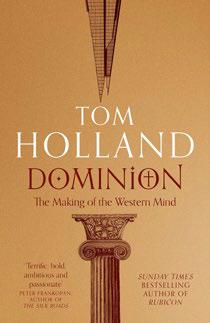Dominion: The Making of the Western Mind
 TOM HOLLAND
TOM HOLLAND
LITTLE, BROWN, 2019
So how did we get the culture, structure and morality of the Western world? Where did it come from? For many of us there is a vague feeling that many of the good things we appreciate in the West started in Ancient Greece but came to fulfilment in the Enlightenment. At that point in history humankind awakened to its own sweet reason and became aware of self-evident truths such as, for example, “all men are created equal”.
Not so, says eminent historian Tom Holland in his tremendously written book, Dominion: The Making of the Western Mind. These so-called ‘self-evident truths’ are not self-evident at all. Having written extensively on Ancient Rome and then having turned to Islamic history, Tom Holland has swum in different historical cultures, cultures that show no indication of seeing the self-evidence of such truths as Thomas Jefferson wrote about. Christianity is the towering force that has shaped the Western mind and continues to have impact even in institutions and societies that have long rejected, or even spurned faith. It is from Christianity that springs all the many concepts we have long taken for granted, such as women’s rights, freedom, science and secularism just to name a few. Many a Christian has suggested as such but Holland, who interestingly, is a bit slippery about his own conviction of faith, writes with passion and persuasion.
This wonderful book is less church history and more postcards of the past, as Holland jumps from era to era like solid stepping stones across a mighty river. The glorious tour starts in 479 BC in Athens jumping to 63 BC Jerusalem and then AD 19 Galatia and so on, until we get to the final step landing in 2015 AD in the German town of Rostock. Holland’s prose has a commanding yet gentle style. He writes like a movie director as each stepping stone has it’s own internal story that links to a larger one. With his eye for detail and original angles, the world of the past rises up, pulses with life and dust clouds of colour. He also has many allusions to scripture and other works that are pleasingly not formally quoted. For example his description of Calvin’s Geneva “The shelter that the city could offer refugees was like streams of water to a panting deer.” One can almost feel the joy he has in creating each elegant, articulate chapter: learned but unencumbered by heavy scholastic drapery. Holland’s target audience is not academics of history. It’s the general public. It’s you and me.
So you may have gathered I liked this book. Just do yourself a favour: read it yourself and feel the fog of this modern world, with its vague assumptions of the past, evaporate.
TIM CHAPPELL, WA
